The Positive Patient Identification Market is estimated to be valued at USD 2.8 billion in 2025 and is projected to reach USD 7.5 billion by 2035, registering a compound annual growth rate (CAGR) of 10.5% over the forecast period.
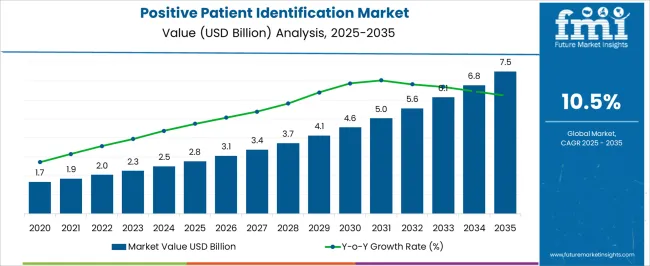
| Metric | Value |
|---|---|
| Positive Patient Identification Market Estimated Value in (2025E) | USD 2.8 billion |
| Positive Patient Identification Market Forecast Value in (2035F) | USD 7.5 billion |
| Forecast CAGR (2025 to 2035) | 10.5% |
The Positive Patient Identification market is witnessing robust growth, driven by the increasing need to enhance patient safety, reduce medical errors, and improve clinical workflow efficiency. The adoption of advanced identification technologies is being supported by hospitals and healthcare providers seeking to minimize risks associated with patient misidentification and ensure compliance with regulatory standards.
Integration of software-based solutions enables real-time verification, automated alerts, and seamless data management, enhancing operational efficiency and clinical accuracy. Rising awareness among healthcare professionals and administrators about patient safety protocols, coupled with the increasing adoption of electronic health records and digital healthcare systems, is further driving market growth.
Technological advancements, including mobile-enabled identification, biometric verification, and AI-assisted patient matching, are enhancing the reliability of identification systems As healthcare facilities prioritize patient-centered care and regulatory adherence, the Positive Patient Identification market is expected to sustain long-term growth, with software-driven solutions and system integration playing a pivotal role in reducing clinical risks and improving overall healthcare outcomes.
The positive patient identification market is segmented by type, end use, patient type, and geographic regions. By type, positive patient identification market is divided into Software, Hardware, and Service. In terms of end use, positive patient identification market is classified into Hospitals, Diagnostic Centers, and Laboratories. Based on patient type, positive patient identification market is segmented into Adult, Baby, Pediatric, and Maternity. Regionally, the positive patient identification industry is classified into North America, Latin America, Western Europe, Eastern Europe, Balkan & Baltic Countries, Russia & Belarus, Central Asia, East Asia, South Asia & Pacific, and the Middle East & Africa.
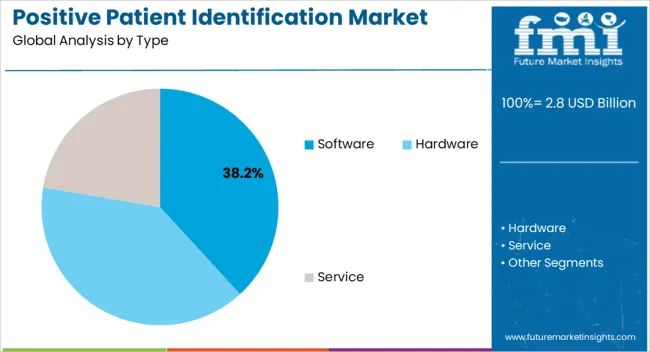
The software segment is projected to hold 38.2% of the market revenue in 2025, establishing it as the leading type. Growth in this segment is driven by the ability to provide scalable, flexible, and automated patient identification solutions that integrate with hospital information systems and electronic health records. Software-based platforms enable real-time verification, reduce manual errors, and enhance patient data accuracy.
Advanced functionalities, including biometric recognition, barcode scanning, and AI-enabled alerts, improve clinical workflow efficiency and ensure adherence to patient safety protocols. The adaptability of software solutions allows deployment across multiple departments and facilities without significant hardware changes.
Hospitals benefit from reduced administrative burden, enhanced compliance, and improved operational efficiency As healthcare facilities increasingly focus on digital transformation, regulatory compliance, and minimizing adverse events, the software segment is expected to maintain its leadership, supported by continuous innovation in AI, analytics, and system integration.
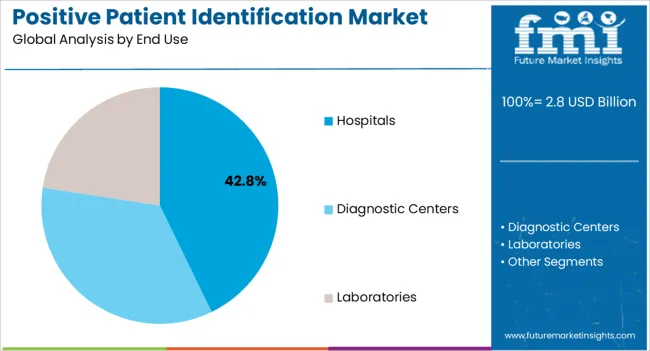
The hospitals segment is anticipated to account for 42.8% of the market revenue in 2025, making it the leading end-use industry. Hospitals are leveraging positive patient identification systems to reduce clinical errors, ensure correct medication administration, and enhance overall patient safety. Integration with electronic health records and clinical management systems allows real-time patient verification and automated alerts for mismatched information.
The rising adoption of patient safety initiatives, regulatory mandates, and quality assurance programs has accelerated deployment. Hospitals benefit from improved workflow efficiency, reduced administrative burden, and compliance with healthcare standards.
As hospitals increasingly prioritize patient-centric care, digital transformation, and risk mitigation, this segment is expected to remain the largest revenue contributor in the market The growing emphasis on operational efficiency and data-driven clinical decision-making further reinforces the adoption of identification solutions in hospital settings.
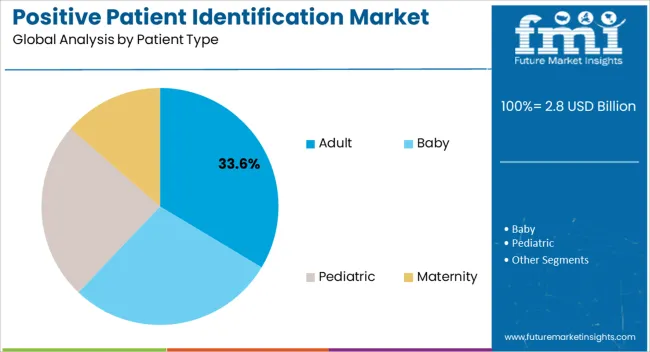
The adult patient type segment is projected to hold 33.6% of the market revenue in 2025, positioning it as the leading patient category. Growth in this segment is driven by the higher volume of adult patients requiring inpatient and outpatient services across hospitals and clinics.
Adults often present with complex medical histories, chronic conditions, and multi-department care needs, making accurate identification critical for treatment accuracy and safety. Positive patient identification solutions help reduce errors related to medication administration, surgical procedures, and diagnostic testing in adult populations.
The integration of software-based verification systems ensures reliable patient matching and data consistency, improving clinical workflow and operational efficiency As healthcare providers increasingly focus on patient safety, regulatory compliance, and minimizing adverse events, the adult patient segment is expected to maintain its market leadership, supported by continued advancements in digital identification technologies, AI-enabled verification, and real-time monitoring capabilities.
A handheld device through which information related to a particular patient can be obtained is known as positive patient identification. In order to ensure better delivery of medication and patient safety, this device is gaining significant adoption among medical professionals across the globe.
For instance, a nurse can obtain patient information through bar code installed on the wrist band ensuring proper medication delivery to the patient and access to the patient records in a proper manner. With increasing advancements in medical technology, development of such devices is anticipated to be a breakthrough and hence, the positive patient identification market is expected to record significant growth in the near future.
With increasing demand for automated systems ensuring effective medicinal administration, demand for devices such as positive patient identification is anticipated to witness significant growth in the near future.
Manufacturers of positive patient identification device are focused on developing advanced products ensuring more functionality and compatibility with computers. Pointers such as right diagnosis, right indicators, right time, right test and right patient are key essentials for positive patient identification manufacturers across the globe.
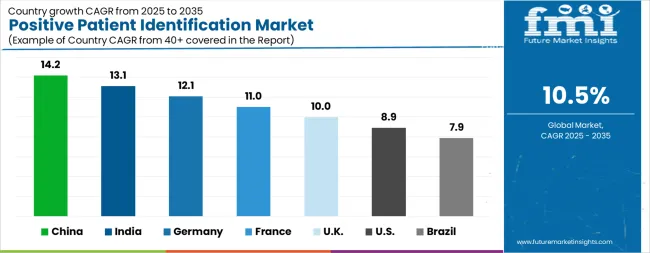
| Country | CAGR |
|---|---|
| China | 14.2% |
| India | 13.1% |
| Germany | 12.1% |
| France | 11.0% |
| UK | 10.0% |
| USA | 8.9% |
| Brazil | 7.9% |
The Positive Patient Identification Market is expected to register a CAGR of 10.5% during the forecast period, exhibiting varied country level momentum. China leads with the highest CAGR of 14.2%, followed by India at 13.1%. Developed markets such as Germany, France, and the UK continue to expand steadily, while the USA is likely to grow at consistent rates. Brazil posts the lowest CAGR at 7.9%, yet still underscores a broadly positive trajectory for the global Positive Patient Identification Market. In 2024, Germany held a dominant revenue in the Western Europe market and is expected to grow with a CAGR of 12.1%. The USA Positive Patient Identification Market is estimated to be valued at USD 1.0 billion in 2025 and is anticipated to reach a valuation of USD 2.4 billion by 2035. Sales are projected to rise at a CAGR of 8.9% over the forecast period between 2025 and 2035. While Japan and South Korea markets are estimated to be valued at USD 132.7 million and USD 70.1 million respectively in 2025.
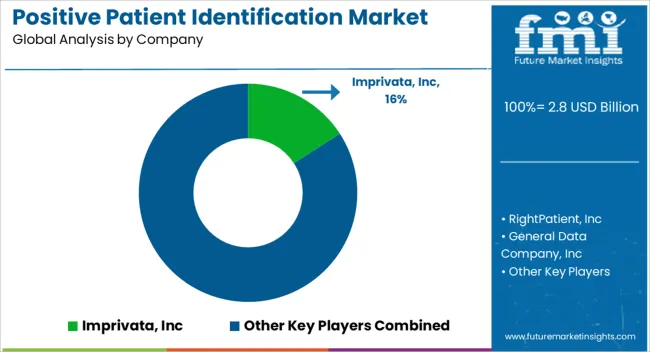
| Item | Value |
|---|---|
| Quantitative Units | USD 2.8 Billion |
| Type | Software, Hardware, and Service |
| End Use | Hospitals, Diagnostic Centers, and Laboratories |
| Patient Type | Adult, Baby, Pediatric, and Maternity |
| Regions Covered | North America, Europe, Asia-Pacific, Latin America, Middle East & Africa |
| Country Covered | United States, Canada, Germany, France, United Kingdom, China, Japan, India, Brazil, South Africa |
| Key Companies Profiled | Imprivata, Inc, RightPatient, Inc, General Data Company, Inc, GBS Corporation, MSoft eSolutions Ltd., PatientWorks Corporation, SATO Holdings Corporation, Zebra Technologies, and RMS Omega Technologies Group, Inc |
The global positive patient identification market is estimated to be valued at USD 2.8 billion in 2025.
The market size for the positive patient identification market is projected to reach USD 7.5 billion by 2035.
The positive patient identification market is expected to grow at a 10.5% CAGR between 2025 and 2035.
The key product types in positive patient identification market are software, hardware, _printers, _wristbands, _labels, service, _on-premise or cloud and _off premise.
In terms of end use, hospitals segment to command 42.8% share in the positive patient identification market in 2025.






Our Research Products

The "Full Research Suite" delivers actionable market intel, deep dives on markets or technologies, so clients act faster, cut risk, and unlock growth.

The Leaderboard benchmarks and ranks top vendors, classifying them as Established Leaders, Leading Challengers, or Disruptors & Challengers.

Locates where complements amplify value and substitutes erode it, forecasting net impact by horizon

We deliver granular, decision-grade intel: market sizing, 5-year forecasts, pricing, adoption, usage, revenue, and operational KPIs—plus competitor tracking, regulation, and value chains—across 60 countries broadly.

Spot the shifts before they hit your P&L. We track inflection points, adoption curves, pricing moves, and ecosystem plays to show where demand is heading, why it is changing, and what to do next across high-growth markets and disruptive tech

Real-time reads of user behavior. We track shifting priorities, perceptions of today’s and next-gen services, and provider experience, then pace how fast tech moves from trial to adoption, blending buyer, consumer, and channel inputs with social signals (#WhySwitch, #UX).

Partner with our analyst team to build a custom report designed around your business priorities. From analysing market trends to assessing competitors or crafting bespoke datasets, we tailor insights to your needs.
Supplier Intelligence
Discovery & Profiling
Capacity & Footprint
Performance & Risk
Compliance & Governance
Commercial Readiness
Who Supplies Whom
Scorecards & Shortlists
Playbooks & Docs
Category Intelligence
Definition & Scope
Demand & Use Cases
Cost Drivers
Market Structure
Supply Chain Map
Trade & Policy
Operating Norms
Deliverables
Buyer Intelligence
Account Basics
Spend & Scope
Procurement Model
Vendor Requirements
Terms & Policies
Entry Strategy
Pain Points & Triggers
Outputs
Pricing Analysis
Benchmarks
Trends
Should-Cost
Indexation
Landed Cost
Commercial Terms
Deliverables
Brand Analysis
Positioning & Value Prop
Share & Presence
Customer Evidence
Go-to-Market
Digital & Reputation
Compliance & Trust
KPIs & Gaps
Outputs
Full Research Suite comprises of:
Market outlook & trends analysis
Interviews & case studies
Strategic recommendations
Vendor profiles & capabilities analysis
5-year forecasts
8 regions and 60+ country-level data splits
Market segment data splits
12 months of continuous data updates
DELIVERED AS:
PDF EXCEL ONLINE
Patient Identification Wristbands Market Analysis – Size, Trends & Forecast 2025 to 2035
Patient-Controlled Analgesia Pumps Market Size and Share Forecast Outlook 2025 to 2035
Patient Transportation Market Size and Share Forecast Outlook 2025 to 2035
Patient Handling Equipment Market Size and Share Forecast Outlook 2025 to 2035
Patient Monitoring System Market Size and Share Forecast Outlook 2025 to 2035
Patient Positioning Equipment Market Size and Share Forecast Outlook 2025 to 2035
Positive Airway Pressure Devices Market Size and Share Forecast Outlook 2025 to 2035
Positive Displacement Blowers Market Size and Share Forecast Outlook 2025 to 2035
Patient Monitoring Accessories Market Size and Share Forecast Outlook 2025 to 2035
Patient Self-Service Kiosks Market Size and Share Forecast Outlook 2025 to 2035
Patient Recliners Market Size and Share Forecast Outlook 2025 to 2035
Positive Displacement Sanitary Pumps Market Size and Share Forecast Outlook 2025 to 2035
Patient Monitoring Devices Market Size and Share Forecast Outlook 2025 to 2035
Patient Transport Services Market Size and Share Forecast Outlook 2025 to 2035
Patient Engagement Platforms Market Size and Share Forecast Outlook 2025 to 2035
Patient Registry Software Market Size and Share Forecast Outlook 2025 to 2035
Positive Air Pressure Devices Market Size and Share Forecast Outlook 2025 to 2035
Patient Positioning System Analysis by Product Type and by End User through 2035
Patient Lateral Transfer Market - Innovations, Demand & Forecast 2035
Positive Displacement Pumps Market Growth - Trends & Forecast 2025 to 2035

Thank you!
You will receive an email from our Business Development Manager. Please be sure to check your SPAM/JUNK folder too.
Chat With
MaRIA